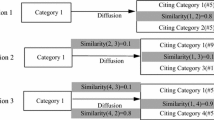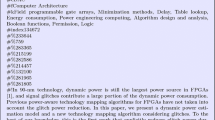Abstract
Interdisciplinarity is as trendy as it is difficult to define. Instead of trying to capture a multidimensional object with a single indicator, we propose six indicators, combining three different operationalizations of a discipline, two levels (article or laboratory) of integration of these disciplines and two measures of interdisciplinary diversity. This leads to a more meaningful characterization of the interdisciplinarity of laboratories’ publication practices. Thanks to a statistical analysis of these indicators on 600 CNRS laboratories, we suggest that, besides an average value of interdisciplinarity, different laboratories can be mainly distinguished by the “distance” between the disciplines in which they publish and by the scale at which interdisciplinary integration is achieved (article or laboratory).


Similar content being viewed by others
Notes
We exclude the JSC “Multidisciplinary Sciences” from analysis because by definition this JSC mixes articles (often monodisciplinary) from many disciplines.
References
Blondel, V. D., Guillaume, J.-L., Lambiotte, R., & Lefebvre, E. (2008). Fast unfolding of communities in large networks. Journal of Statistical Mechanics, 2008, P10008.
Fortunato, S., & Barthélemy, M. (2007). Resolution limit in community detection. Proceedings of the National Academy of Sciences United States of America, 104, 36–41.
Grauwin, S., & Jensen, P. (2011). Mapping scientific institutions. Scientometrics, 89, 943–954.
Kessler, M. M. (1963). Bibliographic coupling between scientific articles. American Documentation, 24, 123–131.
Larivière, V., & Gingras, Y. (2013). Measuring interdisciplinarity over the course of a century. In B. Cronin & C. Sugimoto (Eds.), Next generation metrics: Harnessing multidimensional indicators of scholarly performance. Cambridge, MA: MIT Press.
Leydesdorff, L. (2007). Betweenness centrality as an indicator of the interdisciplinarity of scientific journals. Journal of the American Society for Information Science and Technology, 58(9), 1303–1319.
Leydesdorff, L., & Rafols, I. (2008). A global map of science based on the ISI subject categories. Journal of the American Society for Information Science and Technology, 60(2), 348–362.
Marcovich, A., & Shinn, T. (2011). Where is disciplinarity going? Meeting on the borderland. Social Science Information, 50(3–4), 582–606.
Porter, A. L., & Rafols, I. (2009). Is science becoming more interdisciplinary? Measuring and mapping six research fields over time. Scientometrics, 81, 719–745.
Rafols, I., Leydesdorff, L., O’Hare, A., Nightingale, P., & Stirling, A. (2012). How journal rankings can suppress interdisciplinarity. The case of innovation studies and business and management. Research Policy, 41, 1262–1282.
Roessner, D., Porter, A. L., Nersessian, N. J., & Carley, S. (2013). Validating indicators of interdisciplinarity: Linking bibliometric measures to studies of engineering research labs. Scientometrics, 94, 439–468.
Soós, S., & Kampis, G. (2012). Beyond the basemap of science: Mapping multiple structures in research portfolios: evidence from Hungary. Scientometrics, 93, 869–891.
Stirling, A. (2007). A general framework for analysing diversity in science, technology and society. Journal of the Royal Society Interface, 4(15), 707–719.
Wagner, C. S., Roessner, J. D., Bobb, K., Klein, J. T., Boyack, K. W., Keyton, J., et al. (2011). Approaches to understanding and measuring interdisciplinary scientific research (IDR): A review of the literature. Journal of Informetrics, 5(1), 14–26.
Weingart, P., & Stehr, N. (2000). Practicing interdisciplinarity. Toronto: University of Toronto Press.
Acknowledgments
We thank the “Service d’appui à la politique et à la prospective scientifiques” of the CNRS provided publication data related to CNRS laboratories for our research work. We also thank the CNRS Interdisciplinary Mission for financial support.
Author information
Authors and Affiliations
Corresponding author
Rights and permissions
About this article
Cite this article
Jensen, P., Lutkouskaya, K. The many dimensions of laboratories’ interdisciplinarity. Scientometrics 98, 619–631 (2014). https://doi.org/10.1007/s11192-013-1129-y
Received:
Published:
Issue Date:
DOI: https://doi.org/10.1007/s11192-013-1129-y




